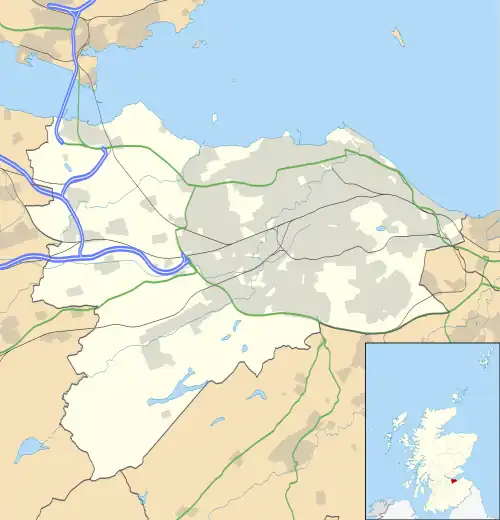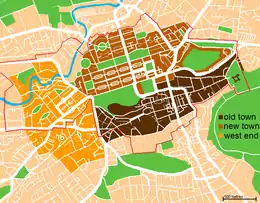Ardmillan
Ardmillan (Scottish Gaelic: Aird a' Mhaolain, IPA:[ˈaːɾʲtʲˈaˈvɯːɫ̪ɪn]) is a mainly residential suburb of Edinburgh, Scotland. The area developed during the mid to late Victorian era as Edinburgh expanded and many of the present tenement flats and houses date from this era. The area is bisected by the A70 road and its north-west edge is marked by the Shotts railway line. The area has several pubs, small shops, churches and a cemetery.
Ardmillan
| |
|---|---|
 Ardmillan Terrace | |
 Ardmillan Location within the City of Edinburgh council area  Ardmillan Location within Scotland | |
| Council area | |
| Country | Scotland |
| Sovereign state | United Kingdom |
| Postcode district | EH |
| Dialling code | 0131 |
| Police | Scotland |
| Fire | Scottish |
| Ambulance | Scottish |
Location
The boundary north of Ardmillan is bordered by the area of Dalry. To the west is the area of Gorgie, and to the east is the area of Fountainbridge. Shandon, Polwarth and North Merchiston are to the south of Ardmillan.
Name
The name is from the Court of Session judge, James Craufurd, Lord Ardmillan, who took his name from Ardmillan Castle near Girvan. The name means the "high bare place" in Scottish Gaelic (Aird a' Mhaolain).
History and architecture
The area contains many tenements as well as "Diggers" pub, so called because the gravediggers from the large graveyard in the Ardmillan-Dalry area would go in there after work. Another pub in the area, the Caledonian Sample Room, is often mistakenly assumed to be owned by the nearby Caledonian Brewery (actually it is owned by Punch Taverns).
Ardmillan has two churches. The first is St Michael's Parish Church, which is an ecumenical church. Building of the church began in 1879 and was completed for services in 1883.[1]
There is also an old congregation of Wesleyan Methodists in the area.
Ardmillan is also home to a large, modern health centre called Ardmillan House. The health centre is the location of the South East Scotland Breast Screening Centre.[2][3]
.jpg.webp)
On the southern boundary with North Merchiston is a large public park - Harrison Park.[4] The origins of the park lie with a public purchase of land by Edinburgh City Council in 1886, with additional land expanding the park being bought in 1930.[5]
North Merchiston Cemetery
North Merchiston Cemetery is a garden cemetery that is located in the western part of Ardmillan, west of Ardmillan Terrace and north of Slateford Road.[6][7][8][9] The cemetery was laid out in 1881 and primarily contains late 19th century and early 20th century burials, including over 120 war graves of Armed Forces personnel.[9][10] Graves include Charles Thomas Kennedy and James Davis, both recipients of the Victoria Cross, and footballers Walter Fairgrieve, Bobby Walker and Alex Walker.[10] The cemetery was under private ownership until the early 1990s when it was acquired by the council due to safety concerns over its neglected state. It was originally built to ease overcrowding at the nearby Dalry cemetery.[8]
References
- "Church History". St Michael's Parish Church. Archived from the original on 12 October 2016. Retrieved 22 October 2016.
- "New scanner at Breast Clinic". Edinburgh Evening News. Retrieved 22 October 2016.
- "Breast Screening". NHS Lothian. Retrieved 22 October 2016.
- "Harrison Park". Edinburgh City Council. Archived from the original on 22 October 2016. Retrieved 22 October 2016.
- "Park History". Friends of Harrison Park. Archived from the original on 22 October 2016. Retrieved 22 October 2016.
- "North Merchiston Cemetery". Woodland Trust. Retrieved 16 May 2021.
- "Parks and Greenspaces". Gorgie and Dalry Community Council. Retrieved 16 May 2021.
- Historic Environment Scotland. "Ardmillan Terrace North Merchiston Cemetery With Lodge Gates and Boundary Walls (LB26704)". Retrieved 16 May 2021.
- Historic Environment Scotland. "Edinburgh, Ardmillan Terrace, North Merchiston Cemetery And War Memorial (87698)". Canmore. Retrieved 16 May 2021.
- "Edinburgh's graveyard of heroes is in a shocking state of neglect". Edinburgh Evening News. Retrieved 16 May 2021.
